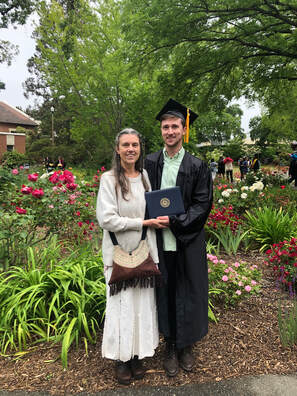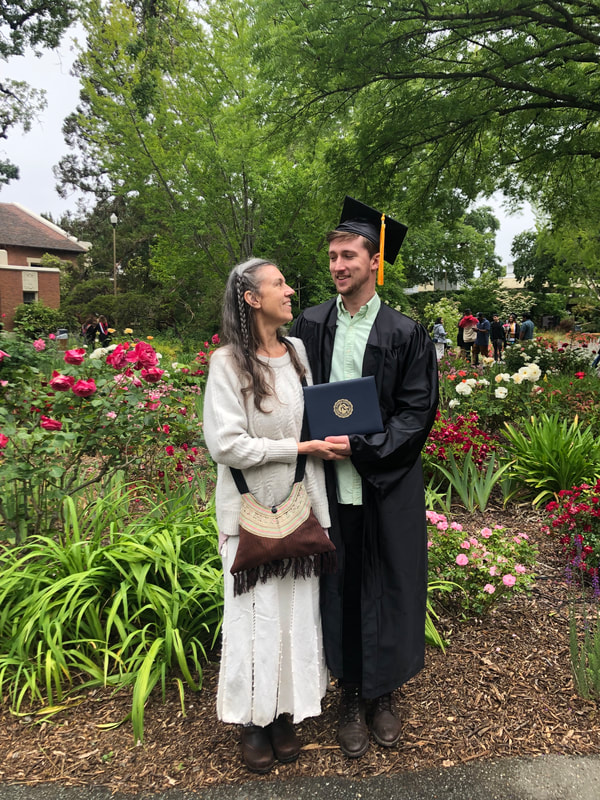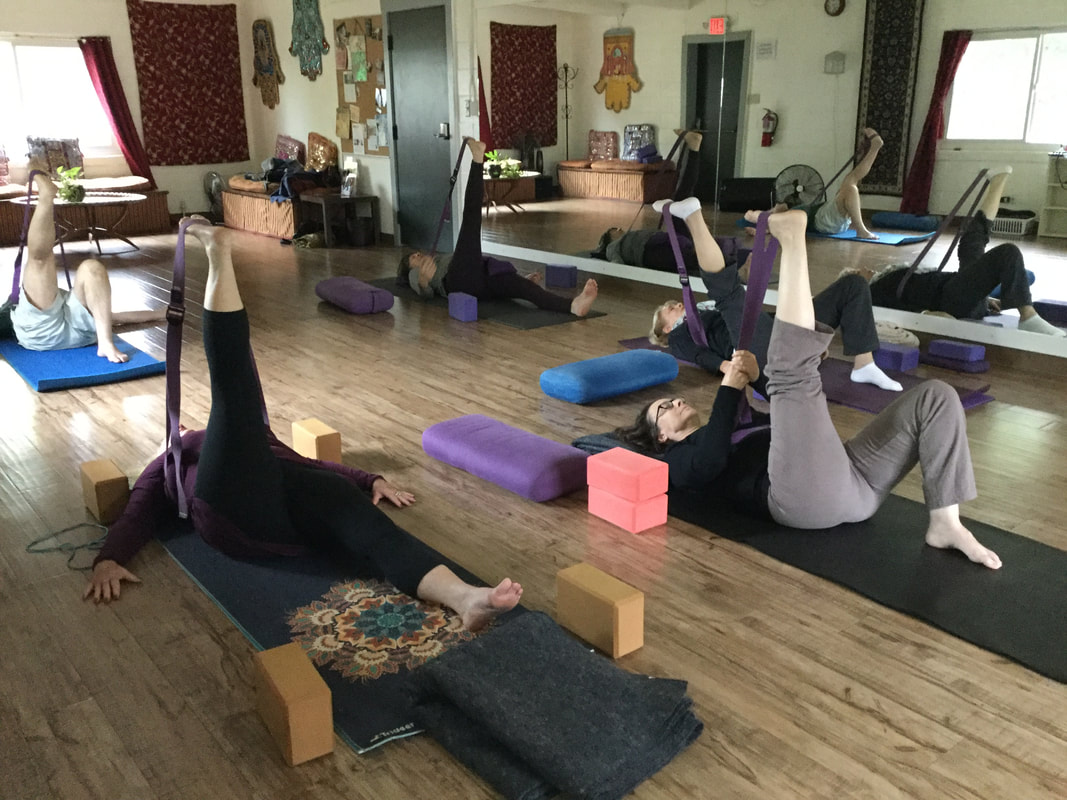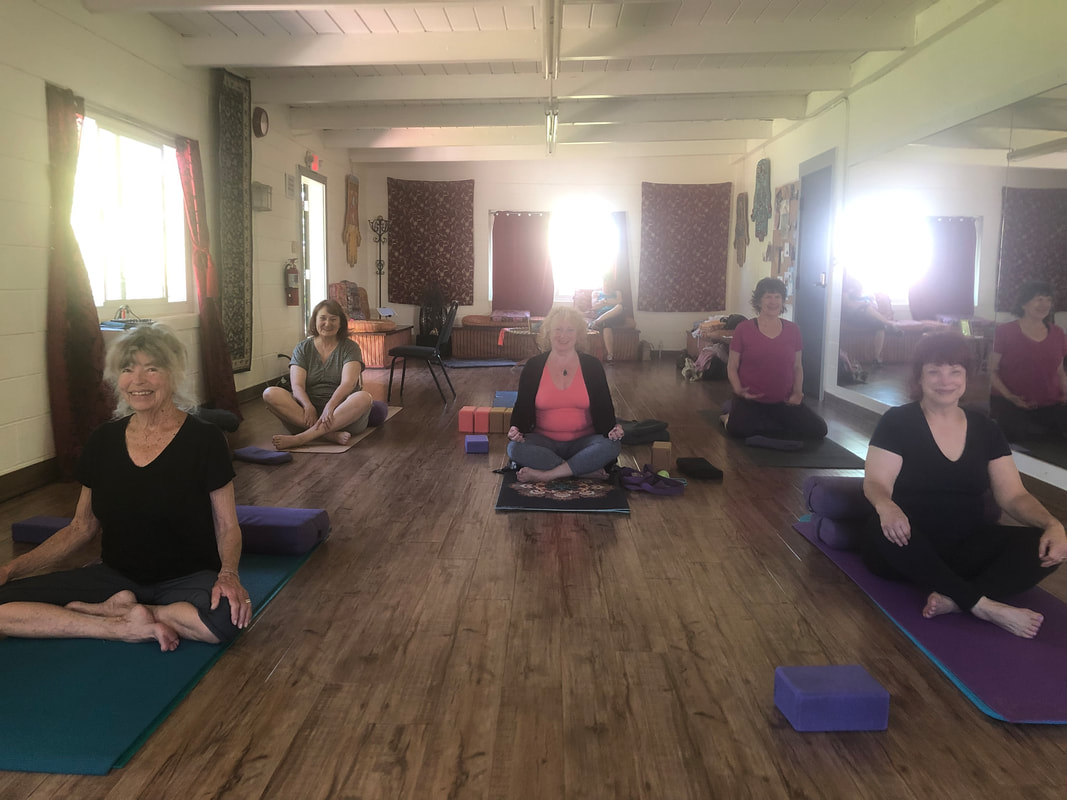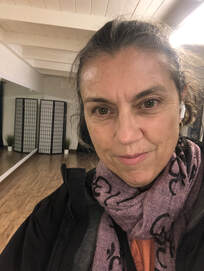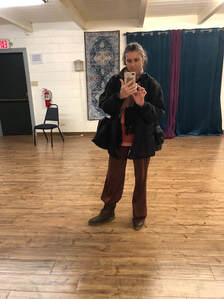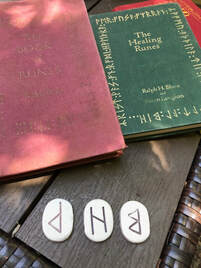 I’ve been working with Runes since my early 20s when my first (and still used) set came to me. I found that this tool of divination has been very useful in gaining insights as well as helping me to see what is going on clearly. Especially through the difficult times when I might not want to look at a particular challenge that I’m being presented with. Like in this spread that I pulled up today. This is not an easy reading. Each of these Runes are in the reversed position. A difficult time for sure. And while this spread points to disruption, a difficult passage, a crisis, or a blockage in what may be wanting to be birthed, it is clear that what is happening is timely for my growth. I am assured that the inner strength I have funded until now in my life is my support and guide during this time of increased challenge. I am encouraged (and even somewhat excited) as I understand and accept what is occurring is clearing away what is no longer needed and is moving me towards more freedom, more expansion, and more love. I am counseled that what is called for here is diligence, to maintain serenity, and to continue to take the steps necessary for this growth and transformation. So, to stay grounded and ride these waves of transformation, I stay steady with my daily practices of PranaVidya and TriYoga flows. Maybe even increasing to twice a day! What this gives to me is this: 1) It brings me back into my body; 2) which brings me back into NOW; 3) which brings spaciousness into my mind; 4) and connects me to higher awareness and my true state of being which is a peaceful, calm, and conscious state of being. What I find when I come out of my dedicated practice and move through each day is this: 1) My mind is clear, clarity emerges; 2) I hear the inner guidance giving direction; 3) I follow the inner guidance that is given, which is always correct and always uncomplicated; 4) and even through the difficulties I remain in the witness state and I enjoy the inner state of peace, calm and joy that are ever present . What does not need to happen is my trying to figure out solutions with my mind and my thoughts. That never works and only causes more confusion and rough waves. May you stay steady with your practice through whatever challenges you may be moving through. If you don’t have a practice, hit me up (as they say 😉) and give yourself this gift of serenity. All love, Kashi 💫 7/9/23
2 Comments
I decided to catch the 9:45 pm shuttle tonight, the last one of the night, and spend the night in the airport, to be able to catch my 6:30 am flight. Well, the drive with Sam (not real name) to the airport was great. I'll try to share some of his story and our trip together in this post. We were the only ones on the bus so I sat up front in order to talk to him and learn about his life. He shared so much starting with being born in Vietnam and coming to this country on a boat, when he was just seventeen, all alone. He talked and talked often interrupting his flow of sharing to say, "Wow! I'm talking so much, I never talk this much!" I continued to listen. He told me that although he couldn't speak english, he was able to get a job as a dishwasher. It was at that job where an “angel” (Sam’s words) came into his life and ended up showing him how to navigate in this new world. She basically adopted him, helping him to get an education, learn english, and then helped him go to cosmetology school. He became a hair stylist and also loved to travel. He traveled to many different places in the US and would work for awhile and then travel some more. This lady (his guardian angel) he told me, gave him guidelines on how things worked and what he needed to do to survive in the world. He spoke a lot about this lady and how much she helped him and how grateful he was for her and that he never would have had the life that he had if it wasn't for her. She also helped him to get his commercial license since he liked to drive so much.
We continued our drive to the airport making stops at pick up places, but no one was getting on the bus. At these stops he would offer me drinks and popcorn and whatever else i wanted. I had some popcorn, chocolate and peanuts. We were having fun. Sam then told me that his angel is now 97 years old and she is dying. He was so sad about this. He told me that he had just gotten a call from her caretaker, about an hour earlier, who said if he wanted to see his friend and say goodbye he needed to come right away. We were both quiet for a moment and then he asked me, "would I mind if instead of going to SFO, we first went to Oakland so he could go see her and say goodbye?" Seeing that I had all night, my plane didn’t leave until 6:30 in the morning, I said, "Of course". So into Oakland we went. Me and Sam in this huge and empty bus. We got to where she lived. Sam quickly darted out of the bus while I stayed behind. I looked out the window, I didn’t know where I was, it didn’t look like a safe neighborhood, my mind started to have fearful thoughts, but I felt i was okay. He had left all his stuff in the bus, and of course the bus itself. I checked the street signs so I knew where I was in case I needed to call the police, and the police were just down the street anyway with some kind of police action that was going on. I waited in the bus for about 10 minutes, 15 minutes at the most and then Sam returned crying and thanking me profusely for letting him go see his friend to say goodbye. He couldn't stop thanking me and said that he owed me. I said, "Of course you don't owe me. I'm not in a hurry and this just seemed the right thing to do. I feel honored to be here with you at this time.” We continued on to SFO while we talked about how to honor the memory of his dear friend/guardian angel. I suggested he light a candle for her when he got home. He really liked that idea. He then shared about his children, and how proud he was of them and how much he loved them, one graduating from seventh grade, and another graduating from the JC. He shared about his wonderful life and wife and how blessed he was for all of it. This was such a beautiful moment for me. The meeting of two strangers with vastly different lives, but for some reason I and this soul got to meet and connect in such an intimate way. I feel honored to have been witness to all of this. June 2023 This weekend my son, Tristan, graduated from the Santa Rosa Junior College. He will be transferring to UC Davis and majoring in Economics in the fall. This time is oh so bittersweet. While so proud and happy for my son, I wasn't prepared for the sadness that I would feel. These milestones in a fleeting life are a big deal. From the current experience, opportunity arises spontaneously to reflect on one’s life. The joys, the sorrows, the struggles and the triumphs. And the fact that these beautiful souls that you’ve nourished and raised are going away. They don’t need you in the same way. They’ve even grown beyond you and most likely they have a wisdom far beyond your own wisdom. I know that I see that in my kids. I'm often in awe of them.
I recently heard a meditation teacher say, “The goal of a Master is to create more Masters, not more students.” In the same way, we do our best to raise up our children so that they can go out into the world, thrive in their lives, and contribute to society in a meaningful way. We hope and pray that we’ve given all that we could so that they may have a deep connection to the truth and light inside of themselves and that connection inside will help them to weather any storm that may come. In this season of graduations, endings and new beginnings, I offer these words from Buddha, to my son, to graduates, and to all of us. “Be a light unto yourself. Hold fast to the truth. Look not for refuge to anyone but yourself. The light and truth is inside of you.” Ultimately, I'm teaching you how to relax, how to let go, and how to increase your energy. This is a relaxation like no other. It’s different from that end-of-the-week happy hour. Or collapse on the couch with a movie, or even relaxing with a book. All of those mentioned could all have their place and time, but if you want to experience the relaxation that will permeate throughout your life when your are active and when you are resting. The relaxation that will restore your health and well-being. The relaxation that will increase (not deplete) your energy. Well then, you are in the right place! The practices that I teach in TriYoga will show you how. Yoga is about letting go. It’s about truly learning how to surrender and discovering that true surrender is not about defeat but about soaring to the highest heights! It’s about learning how to live in a state of so much inner peace that the joy just comes shining through.
Constant stress, doing too much, and always being in the fight/flight/freeze state wreaks havoc on the body and mind. I teach you how to relax, not collapse. I had to retrain myself from saying to students, "relax your shoulders", as some walk around with their shoulders rolled forward or squeezed up to their ears. And, from years of holding the shoulders in this way, for some, that is relaxed. But other conditions (to numerous to mention here) have manifested from this misalignment. When I teach, I invite you to gently draw your shoulders down and back applying effort as needed, but not over effort. Not straining or forcing. But how do we find that place when the patterns have been so established? Many years ago when I first discovered that I was over-efforting, over-stretching, over-doing, I was so surprised. I didn’t even realize that I was hurting myself as my tolerance of pain was so high. It took an injury, (a pulled posterior thigh muscle), to give me the opportunity to look at how I was approaching movement and postures. And then with self-inquiry, a growing awareness, and exploration, I began to discover a new way. To heal my injury I worked intuitively and felt that I had to ease up in the way that I was practicing my postures, to where I wasn’t “feeling” anything. I would just form the shape with my body taking care to not stretch. I began to feel my bones and their natural alignments. I began to feel connections between the movements and the natural order of the body's unfoldment of one movement seamlessly into the next. I began to discover how to strengthen not just the large muscle groups, but all the tiny in-between places as well. I started to find that balance between strength and relaxation and how they each supported each other. I began to discover the direct link between my inhale and exhale and how this breath action actually moved my body. So returning to that earlier question, “How do you find that place of not over-efforting?” “Of steadiness and ease?” “Of relaxation in action?” This reminds me of a question that I’ve gotten from students many times: Question: “Where should I be feeling this?” Answer: “Where are you feeling it? " But even so, what are you feeling? What do you think you "should" be feeling? Is there some kind of expectation of a certain feeling/sensation that you think you should be having? Pay attention to what is happening inside of you. Be curious. What does it feel like when you apply effort? When you apply more effort? Too much effort? How about easing back? What are you noticing? Is your body relaxed? Is the breath flowing also without strain? You just continue on like this. Keep Ahimsa (non-harm) at the fore-front. Every moment, every movement, an inquiry, a discovery, a surrender into the bliss of peaceful awareness. with love, Kashi Ananda Devi “It helps to remember that our spiritual practice is not about accomplishing anything - not about winning or losing - but about ceasing to struggle, and simply relaxing as it is. That is what we are doing when we sit down to meditate. And that attitude spears into the rest of our lives.” ~ Pema Chodron Yesterday I took a break from my daily tasks and duties and ventured over to the Occidental Fool's Day Parade. I had been hearing about this event for years, but finally was able to attend. For this yogi who has been quietly living the yoga lifestyle ~ lots of practice, meditation, and quiet ~ which especially has deepened over the past three years, through pandemic and more recently the winter storms ~ coming out of my quiet yoga space and arriving into Occidental and into the crowds assembled there was an interesting experience.
At first I was a bit nervous about being in such a crowd, but that soon shifted into my being in the witness state, which seemed to arise quite spontaneously. Watching the various characters passing in front of me and then moving into the crowd and finding myself surrounded ~ front, sides, and behind, I discovered was not much different from watching all the different characters that show up with their feelings, agendas, and demands that parade through the mind. And not just when I sit down to meditate, but throughout the day with the non-stop thoughts, feelings and senses. Although the characters in the Fool’s parade were having so much more fun than the ones that show up in my mind who tend to be rather serious, demanding, and often warning of some non-existent danger. I continued to move through the parade coming to the front that was being led by the Hubbub Band. Although there was so much “hubbub” happening around me, I continued to experience the witness state and felt a quiet presence within. And then in the midst of the inner quiet, and the lively music, love, joy, and dancing with abandon that was being expressed around me, I found my own body starting to move and groove in the energy that was flowing. A fleeting thought came in or maybe it was an image in which I was watching from way, way out in space, looking down on planet earth, zooming in to this little town, where the people who have landed here for only a very short time are in this very moment experiencing joy and expressing love without limits. I breath in deeply and give profound thanks to be a part of all of this. May we all experience the Fool, the magical child within; the pure impulse that allows the flow of infinite possibilities in each and every moment. Eye exercises were probably one of the first things that I learned in my beginning yoga classes at age 11 with my ballet/yoga teacher. I never questioned why do we do them, I just did as was instructed. Since I am now releasing a 20 minute video practice on neck and eye exercises, I thought to do some research and see what the state of our eyes are these days, how the yoga exercises could help, and what the science says.
What I found is, that there is not enough scientific evidence that shows that eye exercises will improve eyesight, as is often the claim, or slow the progression of glaucoma, help with dry eye, rebuild ocular strength after cataract surgery, or decrease dark circles under the eyes. There is reason to believe however, that eye yoga and other eye exercises might help with eye strain by decreasing stress and improving focus. In today’s world of technology many are suffering from Computer Vision Syndrome. CVS is similar to carpal tunnel syndrome and other repetitive motion injuries. It happens because your eyes follow the same path over and over. Some of the effects of this could be: blurred vision, double vision, dry, red eyes, eye irritation, headaches, neck or back pain. Eye strain is related to stress, so practicing eye yoga may work in two ways: by actually stimulating and strengthening the 12 muscles (6 in each) that move your eyes, and by bringing down stress levels helping you to remain centered and focused. I notice that I get very relaxed when I do the eye movements along with a complete breath and correct posture. Another study that I found looked at the differences in eye movement range based on age and gaze directions. The eye movements that we do in TriYoga include up and down, side to side, diagonal, circles and distance/up close. In addition, the first eye movement that you learn when you come into a TriYoga class is the Inner Eye Gaze. If you come to my classes, you have heard me explain how to lift the eyes in and up to rest at the space between the eyebrows and 3-4 finger widths in from the front of the forehead, without strain. This study showed that the angle that most quickly decreased with age was the upward movement. Much more so than horizontal or downward. This is right in line with what I’m always saying in class, to lift, extend (in all directions) as with aging the force of gravity (if we don’t do anything about it) will begin to pull everything down, and this includes our eyes! Eventually this body will return to the earth, but let’s not allow that to happen while we are still living! In TriYoga we practice our eye exercises by first making sure our seated posture is correctly aligned. We teach to come into a hip opening posture such as butterfly or tortoise with prop support, but one could also sit on a chair. Just don’t slump down. Sit toward the front of a firm chair, two feet on the floor with knees over the ankles, thighs parallel to the floor, shoulders over the hips, ears over the shoulders. Take a moment to connect to the breath and then when you begin the movements, just like we do in all the other postures and flows, allow the breath to guide. Practice with my new video to learn the sequence for neck and eyes, and then do daily. Remember to take breaks during your computer time for the exercises. And even better ~ go out to nature. Look up, down, side to side, and out into the distance and then get down on the ground and look closely at a flower. Watch the ocean, a sunrise, a sunset. Close your eyes, gently cup your hands over them and feel the healing energy. When you release the hands and open your eyes enjoy the relaxation around your eyes and face and the calm energy that arises. I hope you enjoyed this article. Feel free to share your comments. Now off to rest my eyes! Recently in class a student commented, "I had this idea if I did this (the yoga practice), I would get back to where I was!" They were referring to the physical body, how it was, its limitations and that they can’t do what they used to be able to do.
I have compassion for the student who made this comment. We love our lives and all the things we do. We have an attachment to life and things being a certain predictable way. And yet life is unpredictable and we may grieve for who we used to be and what we used to be able to do. ". . . life is unpredictable and we may grieve for who we used to be and what we used to be able to do." It is a fact that this body is impermanent. It came from the earth and one day will return to the earth. The body changes, it ages. This is a fact. And from my experience with my own body as well as the 100s of students that I have worked with, I’ve seen how long term TriYoga practice supports the body and mind and helps it to meet the physical challenges and changes that come with aging. And in some cases certain things do come back and even improve. One of the mindsets that I sometimes see students come in with is “what do I need to do to get back to where I was? “ And not to say that can’t happen. I try not to ever rule out anything. In my work with students my aim is to meet you where you are today. We explore the postures together and stay present with what is happening for us now. We learn how to get up and down off the floor, what prop to use, how to strengthen, stabilize, balance, how to make shifts and changes in the flows to meet the body's and mind's changing needs. And we might just find a way to "get back" or maybe discover a new way, a new path emerges as the movements and breath increase the prana (life energy) and begin to open up the body and mind and awaken the spirit. "And we might just find a way to "get back" or maybe discover a new way, a new path emerges . . ." In my own journey of yoga postures, I don't think I've ever asked the question, "How can I get back to where I used to be?" For me the question has always been, "It's going to be interesting to see how yoga will meet this body today." Or "How can I use the tools of yoga to help me through this challenge, this difficulty, this stress, this illness?" In other words, "How will yoga meet me today as I am?" I do think that the one of the challenges with a student who is new to yoga is that they are anxious to get “results” right away. And while changes start happening immediately, it may take some time to see it. For students who are coming into the practice later in life, 60-70s, they report to me all the things they CAN do that they couldn’t when they first came in to class. This is usually around the 6 months mark. After a year their yoga practice has become a well-established part of their lifestyle and most cannot imagine missing a session. Yoga meets you as you are and positive changes can happen at any stage of life! "Yoga meets you as you are and positive changes can happen at any stage of life!" I also observe my 60 -70 year old students who have been attending for the past 20 years or more and have a range of movement that is available to them that might not be had they not been practicing, These students have more knowledge of how to move the body, how to be safe, and most importantly how to slow down and pay attention. This greatly lowers the risk of getting injured in daily activities. The meditation, inner focus, mindfulness, positive thinking and deep relaxation helps with an overall sense of feeling more inner peace and joy. In my experience as a yoga teacher/yoga therapist I see positive changes at whatever age students come in. And part of the changes that come is an acceptance of the process and an acceptance of the life journey. And in this gentle acceptance, inner peace permeates. There comes a letting go of what we thought we wanted and we open to the mystery of our continual unfoldment and expansion. And this, we discover, starts to become way more exciting, amazing, and fulfilling than whatever we were clinging onto before. It does happen, all you need to do is begin. ". . . all you need to do is begin." Jaya Guru Devi Kashi Ananda Devi During the onslaught of storms that recently occurred in N. California, I subscribed to our local paper to get the latest on weather and other storm related stories. It was quite exciting and helpful for the most part.
In the days following the storms, I checked into my online news source where I saw story after story of tragedy, death, horrific accidents, suffering, and acts of violence and injustice, each one worse than the next. My nervous system was being shattered. Yesterday morning as I was driving to my studio to meet students, I thought how do I hold this? How do I present these teachings of yoga that guide us into the awareness of the inner peace and joy that resides inside, with all the trauma and drama that is happening collectively and in each individual life? How do I bridge between this changing reality of impulse and reactivity with this higher knowledge of infinite intelligence, love, truth, and eternal joy? And, as is often the case when I’m in a dilemma, I hear the inner voice whisper, “Be still. Listen Inside. The answer will come. You will know what to do. Do not fear.” Sometimes when I'm teaching, I offer the instruction to turn the corners of your mouth upward. On this morning, I heard the guidance inside, telling me to give this to my students. There was a short conversation in my mind with higher presence and I asked, “how can I tell them to smile when there’s so much awful stuff happening in the world? Isn’t that being pollyanna-ish? Isn’t that sticking my head in the sand? Isn’t that spiritual bypassing? ” Inner voice replied, “Just do it anyway.” And so I tell my class, “Turn the corners of your mouth upward.” We are in runner pose. There is quiet, a pause, and then these words come: “Maybe turning the corners of the mouth upward, could be just like any other alignment instruction. Simply, turn the corners of the mouth upward. Just like press your foot to the earth, bring your knee over your ankle, lengthen through the spine, draw the shoulders down away from the ears, maintain the inner eye gaze.” At this point, some of the students began to giggle. And then these words came: “Or, you might want to think of something that could help the corners of the mouth turn up, like a time that you laughed so hard your stomach hurt, or a relationship that brings great Joy, (I am remembering my meeting HHDL and him holding my hand) or a story that you remember that uplifted and inspired.” The giggling among the students started to get stronger. You could feel the spontaneous joy that was bubbling up as our laughter came through. We all felt the blessings of this spontaneous healing. No words were needed. We are One. Om Shanti Om Anandam Feeling content at day's end having reached many who knew to come to practice. Some who were suffering physically, mentally, emotionally, who knew to come. Who maybe were led by inner guidance, or a gentle nudging from a friend or loved one. Go to yoga, the Divine whispers. Find that place of refuge, of calm, of quiet. When the world is in madness and you don’t know what to do, come to the practice. The practice becomes your prayer. Breath for those who can’t breath. Open your heart for all those hearts that are closed. Allow your tears to flow for all of humanity. I’m right here with you and I love you. |
AuthorSimply sharing my thoughts, insights, my journey. I welcome your comments. Archives
July 2023
Categories |
Home |
Classes |
Video Library |
Contact |
(about) |
Copyright © 2021 Kashi Ananda Yoga

